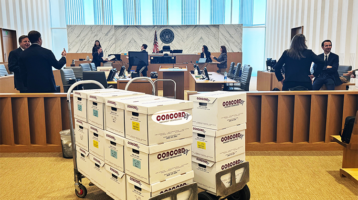Don’t wait until after you’ve been sued to think about e-discovery.
Call CONCORD today. (800) 246-7881
Prior to Litigation
Begin by implementing a document retention policy that provides for the routine destruction of selected data, thereby avoiding the expense of having to sift through reams of irrelevant information later.
A retention policy also reduces the possibility of sanctions and adverse evidentiary inferences, particularly with regard to the routine destruction of electronic materials that occurs before notice of potential litigation or receipt of a document request.
Generally, emails are deleted more frequently than other documents. Many companies are shifting to a policy of “retention by exception,” meaning that emails will be automatically deleted per an established purging schedule unless otherwise marked for retention.
For records other than routine email correspondence, such as employment/personnel records, tax records and environmental records, companies should retain those documents for at least the minimum period required under applicable law or regulation.
Email has become a key repository of evidence for attempts, even if misplaced, to show a company’s “state of mind” in lawsuits and government investigations.
Because emails are often written informally, it may be difficult for a third-party to properly determine the tone and context of the email during discovery. Moreover, emails are easily forwarded and can live on a company’s computer servers long after they have been deleted from a user’s mailbox.
Likewise, text messages and social media are now sources of discovery, so establishing and implementing policies for employee messaging and posting is critical in limiting risk.
Anticipating Litigation
Preservation of evidence takes effect under four general scenarios: when a threat of litigation is made, when litigation is reasonably anticipated or has commenced, when a government agency sends a hold request, or when a non-party subpoena is received.
If litigation or an investigation is anticipated, a company must take steps to ensure that applicable auto-delete features of its IT system are suspended for affected users and that legal holds are implemented for individuals who may have responsive information.
A legal hold directs certain employees to preserve relevant documents. Legal holds may affect recycling of back-up tapes, automatic overwriting, or deletion of emails and other electronic document files, replacement of laptops, as well as storage of voicemail files and instant messenger conversations.
A company’s document preservation strategy is expected to be sensitive to the intricacies of its data management system. Failure to preserve evidence can result in a variety of sanctions, including exclusion of evidence, entry of default judgment, dismissal of claims, award of attorneys’ fees, and even significant fines. Courts have broad powers to sanction parties for the destruction or “spoliation” of evidence, even if the destruction was unintentional.
During Litigation
After a duty to preserve evidence has been identified, a company must determine the scope of ESI that may be subject to the litigation. Several questions require answers:
Who are the key players and custodians?
Where is the data located?
What is the volume of data and how costly is it to retrieve?
Are there any unusual media (i.e., legacy systems no longer operating, non-standard storage methods or back-up tapes)?
What staff and other resources can the client dedicate to the project?
Should the company engage an e-discovery vendor to assist with the collection, processing and production of documents?
Often, because of the sheer amount data, parties will agree on a computer search protocol or methodology, such as keyword searches, Boolean searches, concept searches, metadata filters, language-based approaches using taxonomies and ontologies, and statistical clustering techniques.
Another method that is quickly gaining acceptance is “predictive coding” or “technology assisted review.” In traditional linear review, attorneys review every document that hits a search term. Predictive coding utilizes machine learning technologies to categorize an entire set of documents as responsive or nonresponsive based on human review of a smaller subset of documents. This technology enables the parties to eliminate from human review documents that the software identifies as likely to be irrelevant (subject to appropriate machine training and quality controls) or to prioritize review of documents.
Once litigation has commenced, the parties should discuss the nature of the claims in dispute, possibilities for settlement, and preparing a discovery plan, including discovery of ESI. They should agree on a framework that addresses the format in which ESI will be produced, the volume of relevant ESI, the appropriate search protocol, the discovery timeline, and privilege and waiver issues.
In an adversarial setting such as litigation, it may not be possible for two parties to agree on all e-discovery issues. But parties are typically much better off trying to be transparent about the discovery process and attempting to cooperate instead of running to the judge to complain.
Concord Data Technologies
(800) 246-7881
Preparing for E-Discovery


